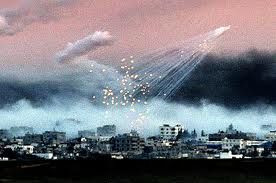The old Richard Goldstone found evidence that Israel committed war crimes in Gaza; the new Richard Goldstone suggests it didn't. Here's the evidence. Decide for yourself where is the truth.
An expanded and revised edition of Norman Finkelstein's This Time We Went Too Far, releasing later this month, refutes Richard Goldstone's recent recantation of his report on Gaza.
This significantly revised and expanded edition is the only comprehensive book-length study of the 2008-2009 Israeli invasion of Gaza and its consequences. It is based on thousands of passages of human rights reports as well as the statements of Israeli soldiers and Israeli officials. It covers the full documentary record - including all the official Israeli reports and investigations - right up until Dec. 31, 2010. In light of Richard Goldstone's recent recantation of the report he authored on the Gaza invasion, Finkelstein's book provides a unique vantage point for judging whether the original report, or Goldstone's current position, is more credible.
The best way to order the Norman Finkelstein's new book is through the website: Paperback is $15 and e-Book is $10. An excellent companion volume, The Goldstone Report: The Legacy of the Landmark Investigation of the Gaza Conflict, edited by Adam Horowitz, Lizzy Ratner and Philip Weiss, is available for $11.25 through the AET Book Club.
Here is an excerpt from the epilogue of This Time We Went Too Far:
Humanitarian Crisis
The massive destruction Israel inflicted on Gaza during the 2008-9 invasion was designed in part to exacerbate the effects of an illegal blockade that had already wreaked havoc for some three years. "I fully expected to see serious damage, but I have to say I was really shocked when I saw the extent and precision of the destruction," the World Food Program director for the Gaza Strip observed after the assault. "It was precisely the strategic economic areas that Gaza depends on to relieve its dependency on aid that were wiped out." The Israel Defense Forces (IDF) targeted critical civilian infrastructure such as the only operative flourmill and nearly all of the cement factories so that Gaza would be evermore dependent on Israeli whim for staples and would not be able to rebuild after a ceasefire went into effect.
A year and a half after the Gaza invasion, major humanitarian and human rights organizations uniformly attested that the people of Gaza continued to suffer a humanitarian crisis on account of the Israeli blockade: "Contrary to what the Israeli government states, the humanitarian aid allowed into Gaza is only a fraction of what is needed to answer the enormous needs of an exhausted people" (Oxfam); "The blockade . . . has severely damaged the economy, leaving 70 to 80 percent of Gazans in poverty" (Human Rights Watch); "Israel is blocking vital medical supplies from entering the Gaza Strip" (World Health Organization); "The closure is having a devastating impact on the 1.5 million people living in Gaza" (International Committee of the Red Cross).
Israeli Prime Minister Netanyahu was nonetheless emphatic that there was "no humanitarian crisis" and "no lack of medicines or other essential items" in Gaza.
"We mustn't tire of reminding others," Parisian media philosopher Bernard- Henri Lévy chimed in, that "the blockade concerns only arms and the material needed to manufacture them." Mocking claims of a humanitarian crisis Deputy Foreign Minister Danny Ayalon gestured to Gaza's "sparkling new shopping mall...new Olympic-sized swimming pool... five-star hotels and restaurants." Israel circulated photographs of these lavish scenes on the Internet. It is true that tiny pockets of prosperity have flourished in the Strip. Harvard political economist Sara Roy noted the emergence of an economic stratum that had "grown extremely wealthy from the black-market economy," and the "almost perverse consumerism in restaurants and shops that are the domain of the wealthy." But for students of the Nazi holocaust such a juxtaposition, however repellent, should hardly surprise. Thus, a survivor of the Warsaw Ghetto recalled:
The sword of the Nazi extermination policy hung over all Jews equally. But a social differentiation arose in the ghetto, setting apart substantial groups who had the means even under those infernal conditions to lead a comparatively full, well-fed life and enjoy some kinds of pleasures. On the same streets where daily you could see scenes of horrors, amid the swarms of tubercular children dying like flies . . . , you would come upon stores full of fine foods, restaurants and cafés, which served the most expensive dishes and drinks. . . . The clientele of these places consisted principally of Jewish Gestapo agents, Jewish police officials, rich merchants who did business with the Germans, smugglers, dealers in foreign exchange and similar kinds of people.
He went on to note that "the Nazis made moving pictures of such festive orgies to show the 'world' how well the Jews lived in the ghetto.
"Regrettably the ensuing debate on whether Israel had put Gazans on a "starvation" or "starvation plus" regimen shifted attention away from and obscured the more fundamental point: What right did Israel have to put the people of Gaza on any diet?
It was also lamentable how even the sternest critics of the blockade nevertheless seconded Israel's right to prevent weapons from reaching Gaza. Even if one accepts the highly debatable contention that, after acquiescing in the international consensus for resolving the conflict, Palestinians still do not have the right of armed resistance to end the occupation, the fact remains that, as Amnesty International has urged (if on different grounds), an arms embargo should be imposed on both Hamas and Israel. It is a curious conception of justice that would deny the victims the means to resist even as they support the legally mandated norms for achieving peace, but allow the perpetrators to replenish their arsenal of repression even as they reject these norms and ride roughshod over them.





Reader Comments
to our Newsletter